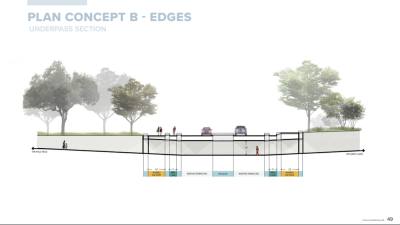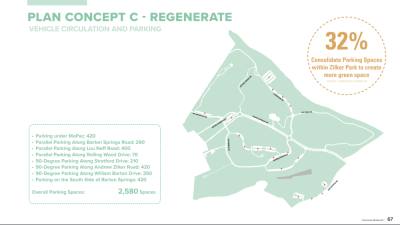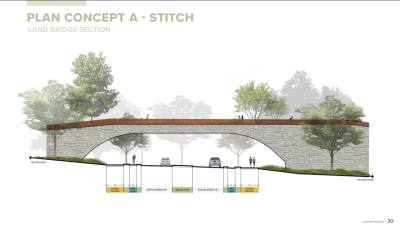The plans proposed at the virtual meeting combine ideas from previous alternatives and community input, according to the city. Each of the three plans includes different solutions to issues in the park, including differing approaches to parking, ecological restoration, safety, accessibility and transportation.
All three plans include the rehabilitation of Barton Creek, the implementation of green stormwater infrastructure, ecological restoration, the coordination of people and roadways, and accessibility for those with disabilities. All three plans also include unique approaches to roadway connectivity and safety, including in-park bus routes with external connectivity to the larger bus system in Austin.
The plans were not presented as definitive options for the community to vote on but instead serve as a way to make decisions moving forward, said Claire Hempel, principal of the consulting firm in charge of the planning effort, Design Workshop.
“These plans came together after all of the engagement that we’ve been doing for over a year now,” Hempel said. “I want to stress that [on] the plan concepts, we are wanting to get your feedback on what elements you like or what resonates with you from each of the concepts as they come together for the final plan.”
The plans
The first plan presented is “Stitch,” with the most prominent features being the creation of a land bridge to make crossing Barton Creek safer and a semi-underground central parking garage with smaller parking near distant areas of interest for visitors.
Stitch:
- Land bridge over Barton Springs Road
- Creation of a sports complex at Rugby Field
- Removal of vehicular traffic from Lou Neff Road
- Disconnect Columbus Drive from William Barton Drive
- Ecological uplift of Butler Landfill with some surface lot parking
- Construction of pedestrian bridge at Toomey Road Extension
- Alteration of Barton Springs Road (2 lanes of traffic, no on-street parking)
- Creation of off-leash area in Polo Field Lawn
- Additional pedestrian/bike bridge connections across Barton Creek
- New location of Zilker Hillside Theater (inside Great Lawn area)
- Realignment of Stratford Drive east of MoPac and closure of existing Stratford alignment to vehicular traffic
Edges:
- Construction of parking garages at perimeter of the park
- Creation of sports complex at Polo Field Lawn
- Construction of tunnel under Barton Springs Road for pedestrians and bikes
- Removal of vehicular traffic from Lou Neff Road
- Removal of vehicular traffic from Andrew Zilker Road
- Ecological uplift of Butler Landfill adjacent to parking garage and Zilker Hillside Theater
- Creation of pedestrian bridge at Toomey Road extension
- Alteration of Barton Springs Road (two lanes of traffic, on-street parking)
- Development of pedestrian/bike bridge across Lady Bird Lake to connect to Austin High School area
- Creation of nature playground and trailhead on west side of MoPac in the Zilker preserve
- Creation of off-leash area near Azie Morton Road/southern part of Zilker Park
- Creation of playground in southern area of Zilker Park
- Additional pedestrian/bike bridge connections across Barton Creek
- New location of Zilker Hillside Theater (to Great Lawn area)
- Realignment of Stratford Drive west of MoPac and closure of existing Stratford alignment
Regenerate:
- Repurposes Caretaker’s Cottage and Quonset Hut to Welcome Center
- Creates a boardwalk on Lady Bird Lake
- Separates bike trail from Butler Hike and Bike Trail along Lady Bird Lake
- Lou Neff Point pedestrian and bike bridge, moves boathouse and dock to the east side of MoPac near Butler Landfill
- Improvements to Barton Spring Road (one lane of travel in each direction and on-street parking)
- Stratford Road remains in its current alignment and open to vehicular traffic
- Ecological uplift of Butler Landfill (meadow with some tree planting)
- Reorganizes and expands surface parking lots
- No parking garages
- Azie Morton Road improvements
- Improves access points into water at Barton Creek (outside of Barton Springs Pool)
The Zilker Park Vision Plan
The Vision Plan is the first comprehensive effort to guide the restoration and future development of Zilker Metropolitan Park and includes recommendations and implementation strategies for improvements in areas such as maintenance, ecology, historical preservation, transportation and others.
In August 2020, Austin City Council authorized the Parks and Recreation Department to work with the consulting firm Design Workshop to develop the Zilker Park Vision Plan. The planning process officially began in February 2021 and has since prompted several community meetings, small group discussions and online surveys of park users.
There are certain facilities on the park premises in the process of determining their own planning, such as the Barton Springs Pool area, the Botanical Gardens and the Nature and Science Center. The type of plans and needs of these facilities made it impossible to include them in the larger and more long-term planning of Zilker Park due to the immediacy of some of their problems, Hempel said.
“Although it would have been great to do everything together and to go into that level of detail for these individual facilities, it just didn’t occur like that,” Hempel said. “But, we have been in really close contact with all of the different planning teams.”
A fifth community meeting is set for June 2022 to discuss plan implementation, but an exact date has not been set. The final draft of the Vision Plan is expected to be completed after that meeting, followed by a review and potential adoption by city boards, commissions and the Council over the summer and into late 2022.
“We really hope that you spend time studying the plans and let us know your thoughts, and get the word out about the survey,” Design Workshop Principal Kurt Culbertson said.
The full presentation of the three vision plans is available on the city’s website, along with ways for the community to share their experiences and opinions on the proposed plans.








